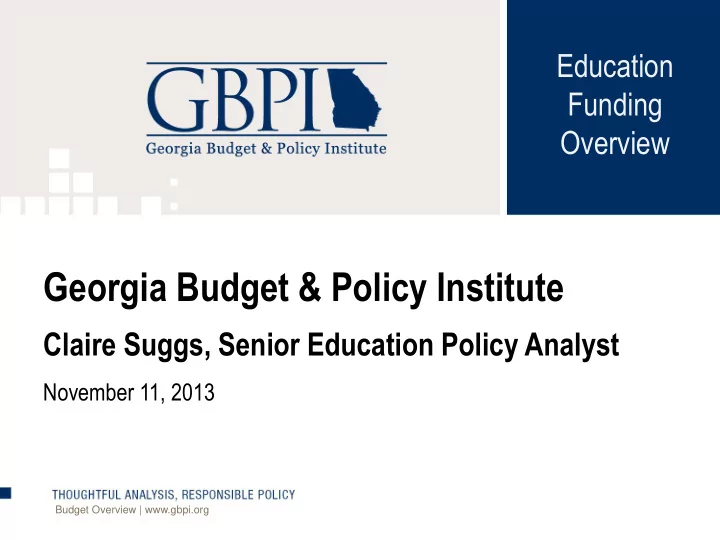

Education Funding Overview Georgia Budget & Policy Institute Claire Suggs, Senior Education Policy Analyst November 11, 2013 Budget Overview | www.gbpi.org
Who We Are State policy think tank Nonprofit Non-partisan Founded in 2004 Budget Overview | www.gbpi.org
Our Policy Area Focus Taxes Budget Education Health Care Economic Security Economic Development Budget Overview | www.gbpi.org
Our work isn’t about the numbers… It’s telling the story of people using numbers
State Funding Since 2002 in Cobb County: State funding per student has declined 16.9 percent • The number of students has grown 11 percent • • The percent of economically disadvantaged students has grown more than 21 percentage points
Shifting responsibility for K-12 funding: Georgia State of Georgia: State of Georgia: Funding sources for K-12 Funding sources for K-12 education, FY2002 education, FY2012 Federal Federal 6% 9% State Local 49% 38% State Local 56% 42% SOURCE: Georgia Department of Education and GBPI research
Shifting responsibility for K-12 funding: Cobb Cobb County: Cobb County: Funding sources for K-12 Funding sources for K-12 education, FY2002 education, FY2012 Federal 3% Federal 6% State 45% State 50% Local 47% Local 49% SOURCE: Georgia Department of Education and GBPI research
K-12 Formula Underfunded by $1 Billion
Austerity Cuts in Cobb County • QBE austerity cut is $65,900,761 for fiscal year 2014. • QBE austerity cut per student is $599. • Cumulative austerity cut is $491,296,767 since 2002.
Local Funding Between 2008 and 2012 in Cobb County: • Tax digest fell 17.8 percent between 2008 and 2012. • Local revenue per student fell by 12.3 percent
Impact of Funding Losses • Cut the school calendar to 175 days • Increase class size • Eliminate 1,380 teaching positions since 2009 • Eliminate 113 instructional support positions since 2009 • Cut central office staff • Rely on reserve funds
Revenues Return to 2007 Levels General and Motor Fuel Funds 2007-2014 Fiscal Years
Drivers of Budget Growth $210 Million K-12 and University System Formula Growth 0 $109 Million Medicaid and PeachCare Growth 0 $127 Million Teacher and Employees Retirement 0 $42 Million Systems Contributions Debt Services 0 $38 Million K-12 Education Equalization 0 $35 Million Department of Justice Settlement Agreement 0
Most Georgia Spending is for Education 51.5% Other Education Georgia’s Fiscal Year 2014 Budget: $18.8 Billion
Health Care is 2nd Largest Budget Expense Other Education 51.5% 51.5% Education Education 20.9% Health Care Georgia’s Fiscal Year 2014 Budget: $18.8 Billion
Many Services in Smaller Category “Other” Other Other 27.6% 51.5% Education 51.5% Education Education Health Care Georgia’s Fiscal Year 2014 Budget: $18.8 Billion
State Spending for “Other” Services Public Safety 9.2% 27.6% Other Other Debt Services 6.4% Other Transportation 4.3% 27.6% General Gov 3.9% 51.5% 51.5% Human Services Education 2.6% Education Judicial Branch 0.9% Legislative Branch 0.4%
State State Savings Depleted During Recession 29 Days of reserves $1,600,000,000 2008 $1,400,000,000 $1.54 B $257 million $1,200,000,000 $260 million 18 $116 million $1,000,000,000 $51 million $793 million $328 million $566 million Days of reserves 2002 $700 million $800,000,000 $103 million 7.6 $600,000,000 $723 M Days of reserves $103 M 2013 $400,000,000 2010 $378 M 2 $200,000,000 $- FY 2001 FY 2002 FY 2003 FY 2004 FY 2005 FY 2006 FY 2007 FY 2008 FY 2009 FY 2010 FY 2011 FY 2012
Q & A Budget Overview | www.gbpi.org
LET’S STAY CONNECTED Please sign up for our electronic email alerts on our website, like us on Facebook and follow us on Twitter. Claire Suggs, Senior Policy Analyst csuggs@gbpi.org www.gbpi.org www.facebook.com/gabudget @gabudget @clairevsuggs
Recommend
More recommend